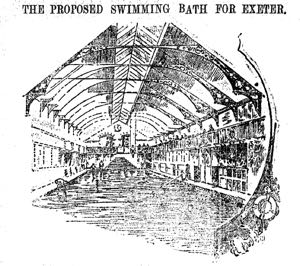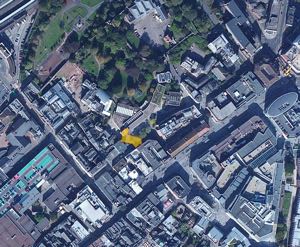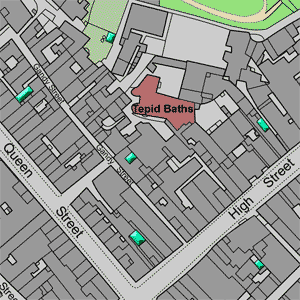
Tepid Baths - King's Alley
Page added 21st June 2015
In Exeter, like many other towns in England before the reign of Queen Victoria, a consortium of local businessmen decided to build a grand bathhouse, in Southernhay, for the use of the wealthy, where they could socialise and take the health benefits of hot and cold baths and showers. On the other hand, the poor did not get any sort of public wash-house until 1852, when such a facility opened at the end of Rack Street.
The idea of using water as a means of keeping fit and for sport did not gain a hold on the public imagination until the 1860s, when James Baker was appointed as Exeter's first bathing ground superintendent on the bank of the river above Head Weir. The Head Weir bathing ground grew in popularity under its second superintendent, Frank Shooter, and swimming became a respectable pursuit. By the late 1880s, thoughts were turning to opening an indoor facility that would be safe from strong currents, bad weather and be open to all.
A new swimming pool
An advert appeared in the Flying Post of the 23 April 1892 for a prospectus for the Exeter Tepid Swimming Bath Company Ltd. The capital was to be £6,000 raised through 1,200 shares at £5 each. Among the directors were Alfred Steele Perkins and Robert Pople, two men who would later become Mayor, the architects were Ralling and Tonar of Bedford Circus. It was stated that "A splendid site has been secured in the very centre of the city", with access from the High Street along King's Alley, and from Gandy Street, on a portion of the land of King's Lodge College. Although the City Council had agreed to supply water at a reduced rate, it was thought that a well could be sunk 30 ft for a large and continuous supply. It was intended to heat "one of the largest Swimming Baths in the Provinces" by the latest method, and to provide hot and cold showers and baths for the large number of people, living in the houses and shops, who had no bath rooms.
The intention for the new company was to have a 'professor' in constant attendance and to provide swimming lessons. During the winter months the pool would be covered over and used for lectures or concerts, bringing in additional revenue. Of course, all shareholders would receive a reduction in the price of a season ticket, a ploy that is still used today when floating a new company.
In September 1892 tenders were invited from builders and contractors, who had to pay a guinea for a copy of the quantities of materials – the guinea was to be returned when a price was submitted. The foundation stone was laid on the 2nd March 1893 by Mr H D Thomas JP, chairman of the company. The almost completed swimming bath was inspected by shareholders and friends in the May, when they found a swimming bath 175 ft long and 30 ft wide, flanked on each side by 42 changing rooms. Over the changing rooms was a gallery capable of holding 500 people to watch swimming and polo matches. A diving board was provided at the 7 ft deep end, while at the opposite 3 ft 6 in., end, there was a fountain directed over the bath. The pool was lined with white glazed bricks with a band of blue bricks running around the top of the sides. Gaslights were provided for the changing rooms, while a large skylight lit the main pool. The visitors were told that it would take six hours to fill the pool. Messrs Thomas Bradford and Co of London and Manchester provided and fitted the steam boiler, the laundry equipment comprising a washing machine, boiling and rinsing troughs, wringer, steam-heated drying closet and mangling machine. The steam boiler heated the pool water by steam injection to a temperature of 68 to 70 F.
The opening
The pool for the Exeter Tepid Swimming Bath Company Ltd was opened by the Mayor, Alderman H F Willey, at 3 pm on Wednesday 28th June 1893. The Mayor, Sheriff and members of the Corporation assembled in the Guildhall and accompanied by constables and mace bearers, walked in procession to the new building, where the pool was declared open from a platform at one end of the baths – Mr Sidney's string band played the National Anthem. Twenty little boys then took the first plunge into the waters, and eight of them held a race, followed by a water polo match. In the evening a Grand Aquatic Carnival was held.
By the next December, the shareholders meeting reported that 17,000 bathers had used the baths in six months but that revenue was not enough to pay a dividend as not all shares had been sold. Over the next few years, the annual meeting for shareholders reported losses and were not able to pay a dividend. In 1911 the baths were taken over by the Corporation.
When the City Swimming Baths (Pyramids) were being planned in 1939, the General Purposes Committee decided to rename the Tepid Baths "The Kings Alley Swimming Baths". Many older citizens of Exeter can remember the pool along King's Alley, and it served the city, alongside the Head Weir Bathing Ground until the Second World War. In May 1942, the bombing raid on the city destroyed two thirds of the High Street and most of the buildings behind, including the tepid baths.
Source: The Flying Post and Kellys 1923.
 The Flying Post printed this picture of
the Tepid Baths in King's Alley.
The Flying Post printed this picture of
the Tepid Baths in King's Alley. The position of the Tepid Baths was in the car park in front of the library.
The position of the Tepid Baths was in the car park in front of the library.
 A 1905 map of the Tepid Baths off the High Street.
A 1905 map of the Tepid Baths off the High Street.
Directors of the Exeter
Tepid Swimming Bath Co Ltd
Henry Drew Thomas JP - Chairman
William
Gordon MB - Barnfield Lodge
Alfred James Hamlin - Holmland
Alfred
Steele Perkins MRCS - Sidwell Street
Robert Pople - New London Hotel
Charles
Edwin Ware JP - Iddesleigh
Matthew John Dunsford - Managing Director
│ Top of Page │